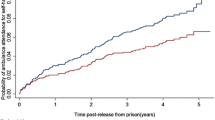Abstract
The monitoring of heroin use and related harms is undertaken in Australia with a view to inform policy responses. Some surveillance data on heroin-related harms is well suited to inform the planning and delivery of heroin-related services, such as needle and syringe provision. This article examines local-area variation in the characteristics of nonfatal heroin overdoses attended by ambulances in Melbourne over the period June 1998 to October 2000 to inform the delivery of services to the heroin-using population in Melbourne. Five so-called hot spot local government areas were considered in relation to the remainder of the Melbourne metropolitan area. Significant local-area variations in the characteristics of nonfatal heroin overdoses were evident over the study period, including the number of heroin overdoses, the age and sex of the people attended, the time of the attendance, the likelihood of hospitalization, and the likelihood of police coattendance. The implications of the finding are discussed in terms of service provision (e.g., opening hours) within the five hot spot local government areas, and it is argued that the analyses undertaken could easily be applied to other jurisdictions for which comparable data are available.
Similar content being viewed by others
References
Darke S, Topp L, Kaye S, Hall W. Heroin use in New South Wales, Australia, 1996–2000: 5 year monitoring of trends in price, purity, availability and use from the Illicit Drug Reporting System (IDRS). Addiction. 2002;97:179–186.
Hando J, Darke S, O’Brien S, Maher L, Hall W. The development of an early warning system to detect trends in illicit drug use in Australia—the Illicit Drug Reporting System. Addiction Res. 1998;6:97–113.
Rumbold G, Fry C. Victorian Drug Trends 1998: Findings From the Melbourne Trial of the Illicit Drug Reporting System (IDRS). Sydney, Australia: National Drug and Alcohol Research Centre; 1999. NDARC Technical Report 73.
Darke S, Ross J, Hall W. Overdose among heroin users in Sydney, Australia. I: prevalence and correlates of nonfatal overdose. Addiction. 1996;91:405–411.
Gerostamoulos J, Staikos V, Drummer OH. Heroin deaths in Victoria: a review of cases for 1997 and 1998. Drug Alcohol Depend. 2001;61:123–127.
Darke S, Ross J, Sunjic S, Zador D. Heroin-Related Deaths in New South Wales 1992–1996. Sydney, Australia: National Drug and Alcohol Research Centre; 1999. NDARC Technical Report 68.
Degenhardt L. Opioid Overdose Deaths in Australia. Sydney, Australia: National Drug and Alcohol Research Centre; 2001.
Hall W, Darke S. Trends in Opiate Overdose Deaths in Australia 1979–1995. Sydney, Australia: National Drug and Alcohol Research Centre; 1997. NDARC Technical Report 49.
Degenhardt L, Hall W, Adelstein B-A. Ambulance Calls to Suspected Drug Overdoses: Analysis of New South Wales Patterns July 1997 to June 1999. Sydney, Australia: National Drug and Alcohol Research Centre; 2000. NDARC Technical Report 94.
Dietze PM, Cvetkovski S, Rumbold GR, Miller P. Ambulance attendance at heroin overdose in Melbourne: the establishment of a database of ambulance service records. Drug Alcohol Rev. 2000;19:27–33.
Bammer G, Ostini R, Sengoz A. Using ambulance service records to examine nonfatal heroin overdoses. Aust J Public Health. 1995;19:316–317.
Fry C, Miller P. Victorian Drug Trends 2001: Findings from the Illicit Drug Reporting System (IDRS). Sydney, Australia: National Drug and Alcohol Research Centre; 2002. NDARC Technical Report 129.
Gossop M, Griffiths P, Powis B, Williamson S, Strang J. Frequency of non-fatal heroin overdose: survey of heroin users recruited in a non-clinical setting. BMJ. 1996;313:402.
Dietze P, Fry C, Rumbold G, Gerostamoulos J. The context, management and prevention of heroin overdose in Victoria, Australia: the promise of a diverse approach. Addiction Res Theory. 2001;9:437–458.
Darke S, Zador D. Fatal heroin “overdose”: a review. Addiction. 1996;91:1765–1772.
Dietze P, Rumbold G, Cvetkovski S, Hanlin K, Laslett A-M, Jonas H. Using populationbased data on alcohol consumption and related harms to estimate the relative need for alcohol services in Victoria, Australia. Eval Program Plam. 2000;23:429–436.
Fitzgerald J, Hamilton M, Dietze P. Walking overdoses: a re-appraisal of non-fatal illicit drug overdoses. Addiction Res. 2000;8:327–355.
Dietze P, Cantwell C, Burgess S. Bystander resuscitation attempts at heroin overdose: does it improve outcomes? Drug Alcohol Depend. 2002;67:213–218.
Victoria Police. Police attendance at incidents of drug overdose. Chief Commissioner’s instructions. The Gazette. February 1999:8.
Dietze PM, Fry CF, Rumbold GR, Gerostamoulos J. The context, management and prevention of heroin overdose in Victoria: the promise of a diverse approach. Addiction Res Theory. 2001;9:437–458.
Midford R, Acres J, Lenton S, Loxley W, Boots K. Cops, drugs and the community: establishing consultative harm reduction structures in two Western Australian locations. Int J Drug Policy. 2002;13:181–188.
Crook GM, Oei TPS. A review of systematic and quantifiable methods of estimating the needs of a community for alcohol treatment services. J Subst Abuse Treat. 1998;15:357–365.
Rush B. A systems approach to estimating the required capacity of alcohol treatment services. Br J Addict. 1990;85:49–59.
Dewitt DJ, Rush BR. Assessing the need for substance abuse services: a critical review of needs assessment models. Eval Program Plann. 1996;19:41–64.
Seidler D, Schmeiser-Rieder A, Schlarp O, Laggner AN. Heroin and opiate emergencies in Vienna: analysis at the municipal ambulance service. J Clin Epidemiol. 2000;53:734–741.
Seidler D, Woisteschlaeger C, Schmeiser-Rieder A, Hirschl MM, Kaff A, Laggner AN. Prehospital opiate emergencies in Vienna. Am J Emerg Med. 1996;14:436–439.
Schulz-Schaeffer W, Peters T, Pueschel K. Drug abuse emergencies in Hamburg 1990/91. Forensic Sci Int. 1993;62:167–171.
Author information
Authors and Affiliations
Corresponding author
Rights and permissions
About this article
Cite this article
Dietze, P., Jolley, D. & Cvetkovski, S. Patterns and characteristics of ambulance attendance at heroin overdose at a local-area level in Melbourne, Australia: Implications for service provision. J Urban Health 80, 248–260 (2003). https://doi.org/10.1093/jurban/jtg028
Issue Date:
DOI: https://doi.org/10.1093/jurban/jtg028




